
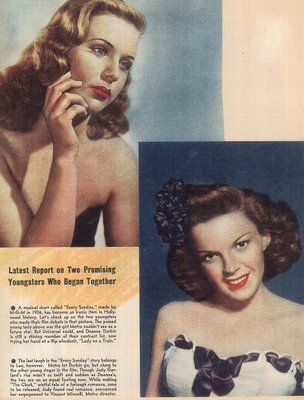 Deanna Durbin --- Part Two
Deanna Durbin --- Part Two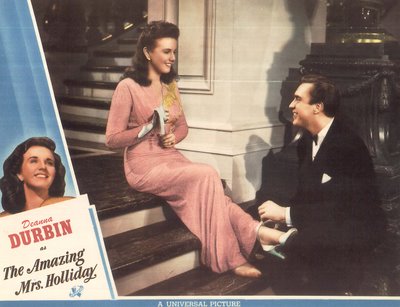
Deanna Durbin’s kind of popularity is unknown today. So few people even go to movies now, let alone read about them the way fan magazine purchasers did in her day. There are still Durbin scrapbooks languishing in attics, lovingly compiled by grandparents when they were teenagers. Hers was the kind of sanctified image that invited the approval of many otherwise indifferent to, or even scornful, of Hollywood. Franklin Roosevelt sent Joseph Stalin a print of His Butler’s Sister as a good will gesture. Axis agencies put word out among prisoners of war and allied troops in remote combat zones that she’d died, knowing this would reduce morale. Upon Japan’s surrender, American occupation forces chose Deanna Durbin features as first to be publicly shown, on the theory that their wholesome and non-political content would encourage calm and cooperation among the populace. I’m told she received $400,000 to do It Started With Eve. That seems a lot, even given her enormous popularity, but the status of having been highest paid woman in the United States seems not to have been challenged. A lot of viewers experiencing Durbin for a first time today will no doubt be skeptical as to accuracy of that --- what were those people thinking? It's still possible to be won over, however, especially if you follow her from beginnings with Three Smart Girls. There was an ingenious continuity running through all the Durbin vehicles. Her Penny Craig character in Three Smart Girls returns in two follow-ups, and in what must have been a nostalgic moment for moviegoers in 1943, "Penny" and her parents watch home movies featuring scenes not only from the first two Smart Girls pics, but other Durbin highlights as well. These clips are woven into the narrative as if all were incidents in Penny Craig's life. Universal was careful not to disrupt age progression for each new Durbin release, this providing a comfort level for young viewers whose own maturing and development could be measured against Deanna’s.
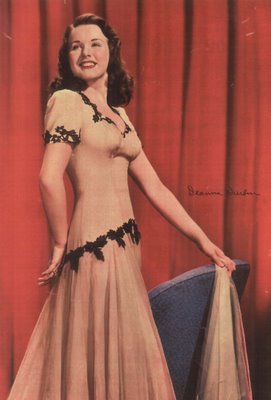

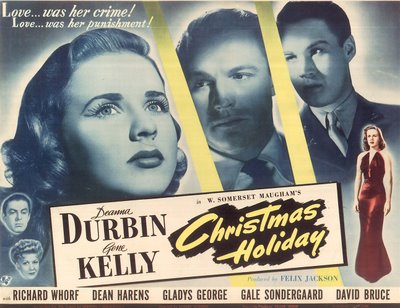
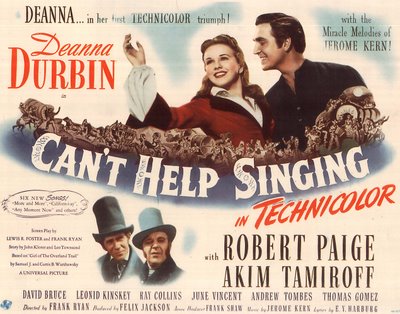
It was these intensely personal connections that assured fan loyalty as Durbin transitioned into romantic leads. She encouraged it, of course, but also realized the identification ended at her front door. Friends and family called her Edna May (actual name), and unlike stars who often confused who they were with who they played, Durbin was always quite clear as to the line of demarcation between Deanna and Edna May. When the fans rejected her noirish turn in Christmas Holiday (Durbin thought it best of the filmic lot), she pretty much went on autopilot for what was left of a performing career. This proprietary interest on the part of her admirers made Durbin a prisoner of Deanna. Any future in serious acting was as foreclosed to her as it would have been to someone standing outside those Universal gates. In fact, she’d wanted out after Christmas Holiday, but was talked into staying for the sake of an ongoing war effort. Durbin did throw a few curves, however, not least of which was an alarmingly sensual quality often summoned up for adult parts. That underlying carnality looms large in otherwise tepid romantic comedy situations wherein Durbin found herself paired off with Universal contract non-starters of the David Bruce and Robert Paige variety. Image and career stagnation also increased her appetite. Paige would later recall bountiful fried chicken picnics while on location for Can’t Help Singing, and by 1945 and Because Of Him, the effects were beginning to show. The spectre of overweight, real and imagined, persisted into retirement, causing Deanna to suspend her cardinal rule against media exposure when she mailed a current (1980), and svelte, photo of herself to LIFE magazine to dispel rumors of latter-day corpulence.
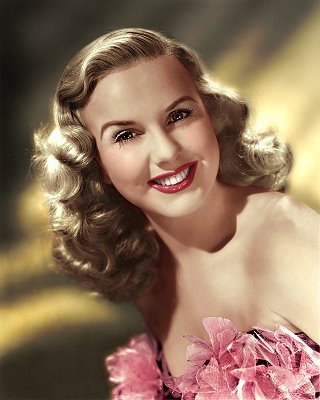
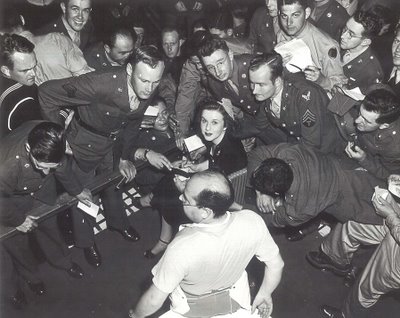
Deanna Durbin said in that 1983 interview that she strongly considered taking the Broadway lead in My Fair Lady, but by then, was committed to family and retirement, so this and other offers (including Metro's for Kiss Me Kate) went unheeded. Buckets of money were offered up, but being among a rarified group of one-time child stars not to have been robbed by parents, Deanna turned all proposals down. Bill Everson wrote a career article for Films In Review in 1976 and received her polite acknowledgment, but Durbin still couldn’t understand why people would be interested in a character she found altogether alien in movies that to her seemed utterly artificial. She'd surface again in 1987, though, writing Everson to correct factual errors in a FIR article concerning Jean Renoir’s involvement with 1943's The Amazing Mrs. Holliday. Her letter on this occasion was detailed and insightful, making all the more regrettable her ongoing disinterest in writing memoirs or submitting to a detailed career interview/overview.
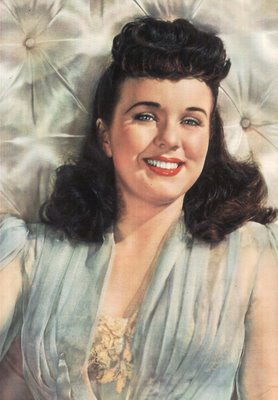
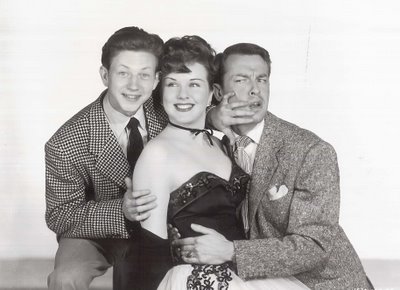
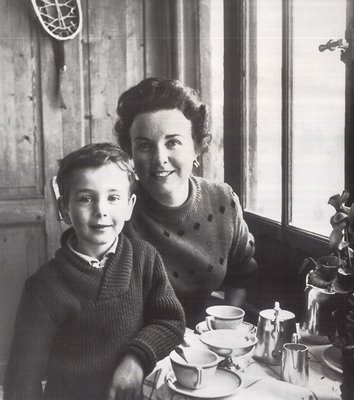
So where are her movies today? Certainly not on television. TCM has run a handful, but Durbin’s never been Star Of The Month, owing no doubt to Universal’s ownership of, and indifference toward, her films. Warners does own It’s A Date, by virtue of Metro having purchased its negative in the late forties for a Jane Powell remake, so that one’s shown often on TCM. A DVD "Sweetheart" pack of six Durbin features turned up several years back, but sales must have been slow, for there’s been no promise of more (until 2010, when five more came out). Her sustained popularity in Great Britain, always the most dedicated outpost in Durbin-land, resulted in Region 2 DVD release of nearly all her output, excepting one mired in ownership dispute (Spring Parade). On one hand, I can understand Universal’s disinterest in promoting movies so old and frankly dated as these. You could say there’s not enough revenue to justify effort of exploiting this franchise, and yet these are corporate assets, and do have a potential, if modest, earning potential. Like any asset, they need to be cultivated. Public awareness and appreciation, even if limited to a niche group, might eventually generate enough sales to increase value of these long dormant properties. I’m thinking not only of Deanna Durbin, but of other Universal groups as well --- W.C. Fields, Alan Ladd, pre-codes, film noir. None of this would happen overnight. These names and titles have been off a public’s radar too long to expect immediate consumer embrace of their revival, but a comeback, if modest, can be achieved by means of satellite broadcasts on Universal’s FLIX channels, licensing to other outlets (such as TCM), and of course, more DVD releases. Universal has gotten a little better about that over the last several months, as we’re seeing DeMille, Lombard, and Cooper groups, plus the Sturges, Cary Grant, and Bing Crosbys to come. Sales expectations should be realistic, though, for it takes time for library assets to find a potential audience and generate meaningful sales. It will also require spending a little money on the front end, without usual guarantees of immediate pay-off (in fact, said pay-off would be anything but immediate), but over time, which Universal and its corporate empire obviously have plenty of, there could be some sort of revenue stream, along with favorable publicity attendant upon any gesture a company makes toward its classic output. We’re all realistic enough to know these old films will never again be major profit centers, but with patient handling, they can certainly be something more than buried relics too long ignored.
Photo Captions
With Robert Cummings and Charles Laughton in It Started With Eve
Fan Magazine Comparison --- Deanna and Judy Garland
With Edmond O' Brien in The Amazing Mrs. Holliday
Fan Magazine and Universal Portraits
Title Lobby Card --- Christmas Holiday
Title Lobby Card --- Can't Help Singing
Color Tinted Portrait by Tom Maroudas of Dream Pin-Ups
Deanna at The Hollywood Canteen
Color Fan Magazine Portrait
With Donald O' Connor and John Dall in Something In The Wind
Deanna in retirement with her son in 1958